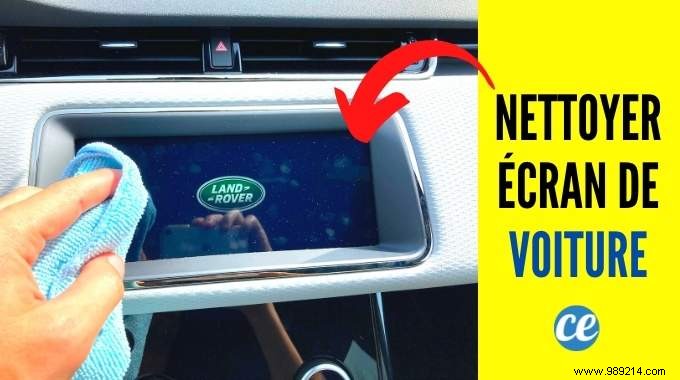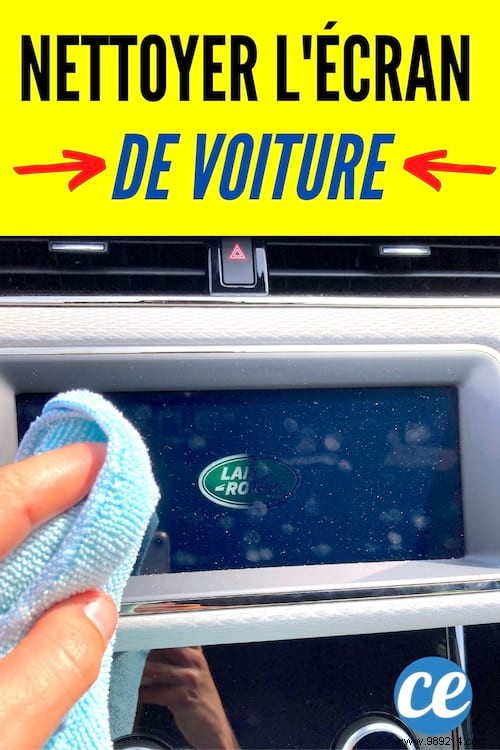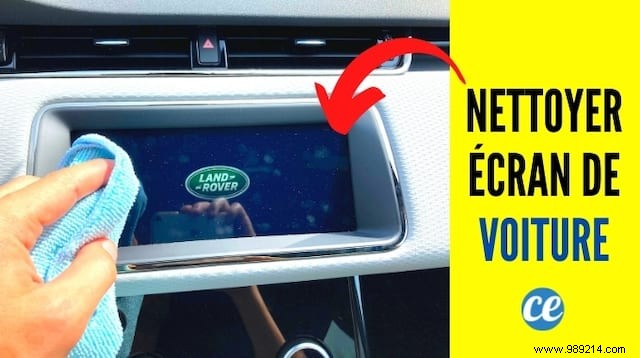
GPS screen, trip computer, multimedia interface...
Touch screens in cars are becoming more and more common in modern cars.
But like any screen, these get dirty quickly, because of fingerprints and other dirt.
Well today, I'm explaining to you what not to do when cleaning car screens.
Because if it is true that they need to be cleaned, it should not be done anyhow.
This could damage them or worse, make certain functions of the car HS!
Discover 9 mistakes not to make when cleaning car touch screens. Watch:

To properly clean your screen, the first thing to do is turn it off.
Why ? The reason is simple and you will soon understand.
Take this silly test:
Leave your screen on and look for fingerprints and dust:you don't see much of it, do you?
Now turn off the screen and do the test again:
It's a horror! There are plenty of fingerprints and dust that you didn't even see before.
As you will have understood, turning off the screen makes it much easier to see traces and dirt.
But that's not all:turning off the screen helps to fight against static electricity.
If this electricity is not drained away, it could damage your system.
So don't stimulate it when you clean the screen.
Switch off the ignition or operate the dedicated control to switch off the monitor.
When it comes to cleaning, there is a golden rule.
The more regularly you clean, the less difficult the stain is to remove!
Conversely; the longer we wait, the more restrictive it is.
Don't forget that your screen suffers a lot of aggression on a daily basis.
Splashes, smudges of all kinds, dust encrusted around the screen and of course fingerprints...
All of this can damage your equipment and even scratch it.
To avoid this phenomenon of accumulation of dirt, pass a light touch on the screen from time to time.
Thanks to your microfiber cloth always nearby, it doesn't even take 1 min.
The basic cleaning to be done about once a month is thus much easier.
Today, everyone knows about the incredible uses of white vinegar.
But unfortunately, there are some tricks that are best avoided when cleaning.
You guessed that car screens are one of them!
Why ? Because white vinegar contains corrosive acid that can damage your screen.
And that's not the only product you shouldn't put on your car screen.
It's the same with soap, because it leaves tiny greasy traces...
...or ammonia which is much too aggressive and far from natural.
Believing you are doing the right thing, as soon as dirt appears, you take out the microfiber cloth and wipe the screen.
What you may not know is the cloth can scratch the screen if used dry!
So, never do that.
Moisten it a little before any application on the screen. This avoids unpleasant surprises.
All you need is a little tap water or even better mineral water.

If dry cleaning of the screen is to be excluded, cleaning in hyper wet mode is also prohibited!
Whether water or other substance, do not spray liquid directly on the screen.
This risks damaging the interface, and above all causing drops to enter behind the monitor.
If so, bye bye your screen! So be careful how much liquid you use.
The safest way is therefore to spray a little cleaning water directly on the microfiber cloth.
Not using aggressive products seems quite logical.
Except that when I talk about an aggressive product, I also mean a product like simple window cleaner.
These substances attack the specific coatings of screens, such as anti-reflective and oleophobic (anti grease).
These 2 characteristics are important for your multimedia screen to work well.
So to avoid damaging them, simply use clean water with a special microfiber glass cloth.
This allows trouble-free daily cleaning.
In case the screen is really grimy, just apply a small amount of hydroalcoholic gel to disinfect everything.
To clean car screens, take nothing but clean microfiber cloths.
And if possible, use special glass ones like these.
Other materials, such as paper towels or toilet paper, scratch the surface of the screen.
Indeed, these papers are not suitable because they are too abrasive and damage the coating.
Besides these 2 materials, also do not use ordinary cloths or dirty microfiber cloths.
Some do not capture dust properly, others leave traces and can scratch.
When applying hydroalcoholic gel or water to the screen, do not let the product air dry.
Indeed, it is important to dry the screen yourself.
Why?
Because if you do that, traces could remain visible on the screen after drying.
So remember to wipe the area with a clean, dry microfiber cloth.
Cleaning the center of the screen is not difficult if you follow our advice.
The problem is the mass of dust and dirt that lodges on the edges of the screen.
By not treating these hard-to-reach areas, residue becomes embedded in the hollows.
So take your canister of compressed air and blow air over the areas.
Once this is done, take a slightly moistened cotton swab and go around the frame with it, without pressing too much.
The cotton swab should simply be used to dislodge stuck impurities; it is not made to clean the whole screen.
Last thing; do not insert any object (leaflet, business cards, etc.) between the edges and the main screen.
This has the effect of creating mini calls for air, allowing the dust to become even more embedded.